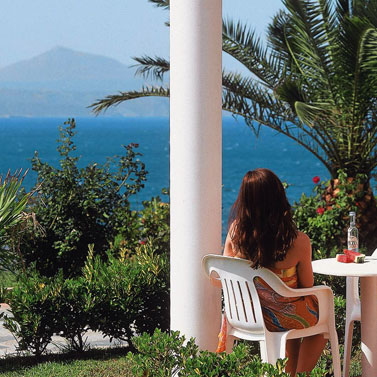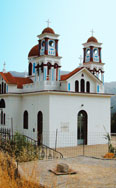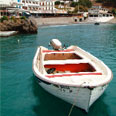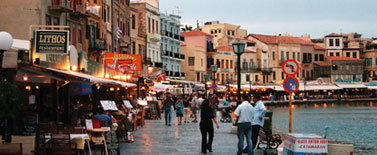- Villa search

- Canaries
- Caribbean
- Croatia, Bulgaria and Hungary
- Cyprus
- Florida
- France and Corsica
- Greece
- Italy
- Lakes and Mountains
- Madeira
- Malta and Gozo
- Portugal
- South Africa
- Spain - Balearics
Information

Irini Studio gardens
“These days, people on the beaches of Crete think of nothing more taxing than which taverna to escape to from the heat of the midday sun”
At the Khrisoskalitissa monastery, high above the sea on the west coast, Dimitris added: “It is a very religious island and you will see that in the way the people are and the respect they show each other.”
We called at the monastery (well worth a stop) on our way to one of the best beaches on Crete – Elafonisi, which has pink sand lapped by a turquoise sea, and the jagged peaks of the White Mountains behind.
The most westerly range on the island, the mountains were a refuge for the Resistance during the last war.
“There are areas of the White Mountains that have never been explored. If I were to dedicate the rest of my life trying to discover every part of them there wouldn’t be time,” Dimitris said wistfully.
As he’s only 45, that gives you some idea of how enormous the range is. Fifty seven of its summits are more than 2,000 metres high and, although only a few hundred miles from Libya, they’re topped with snow in winter. They are vast and untamed, with 3,500 caves and many gorges.

Crete has some impressive churches
A good place to enjoy them without actually climbing a mountain, is the Imbros Gorge, the shorter and less famous cousin of the 18-mile Samaria Gorge. In three miles of fairly easy walking you’ll find a profusion of flowers and fruits growing in the crags and at the end of the walk, fabulous views of the Libyan Sea.
Look out for the rare plant dichtamon, said to be a wonder drug. Make a tisane from two or three leaves, drink it and, hey presto! you’re cured of your illness, whatever it is – well that’s what they say. Then there’s the Cretan goat and the Cretan badger as well as the Cretan spiny mouse and Cretan weasel. Rarest of all is the bearded vulture – only a small number are left on the planet and about a hundred live on Crete. They drop scavenged animal parts from a great height, shattering their bones, before eating them.
If you head south, try to get to Frangokastello, a tiny settlement dwarfed by its huge castle next to the beach. Chora Sfakion is another village with a beach and lots of lively waterside tavernas. You can take a boat ride to Loutro, a few miles further west from here.

Crete’s most famous archaeological sites are the Minoan palace of Knossos, outside Heraklion, and the palaces and amphitheatre at Phaistos in the south. There are plenty of other ruins – Greek and Roman temples, Byzantine churches, Venetian forts, mosques, minarets and, of course, the monasteries.
But they can get crowded – we were glad to get back to our peaceful studio apartment in Almirida, a small village with a sandy beach, crystal sea, atmospheric waterside tavernas and a very relaxed pace of life.
Across the Bay of Souda from Almirida you can see a stretch of hilly land with beautiful white beaches – the eastern side of the Akrotiri peninsula. Two of these beaches belong to tiny Marathi, an even more away-from-it-all place. It has a couple of tavernas and a resident flock of geese and ducks which waddle about the village and swim in the sea. For other good beaches on the peninsula try Kalathas and Stavros, featured in the film Zorba the Greek.

Chania at dusk - getting ready for the night life
home | destinations and editorial | villa search | property for sale | car hire | flights | services
villaseek blog | contact villaseek | links and resources | advertise your villa© Dune Root Ltd and Villaseek.com 2012 - Caribbean
- Canaries